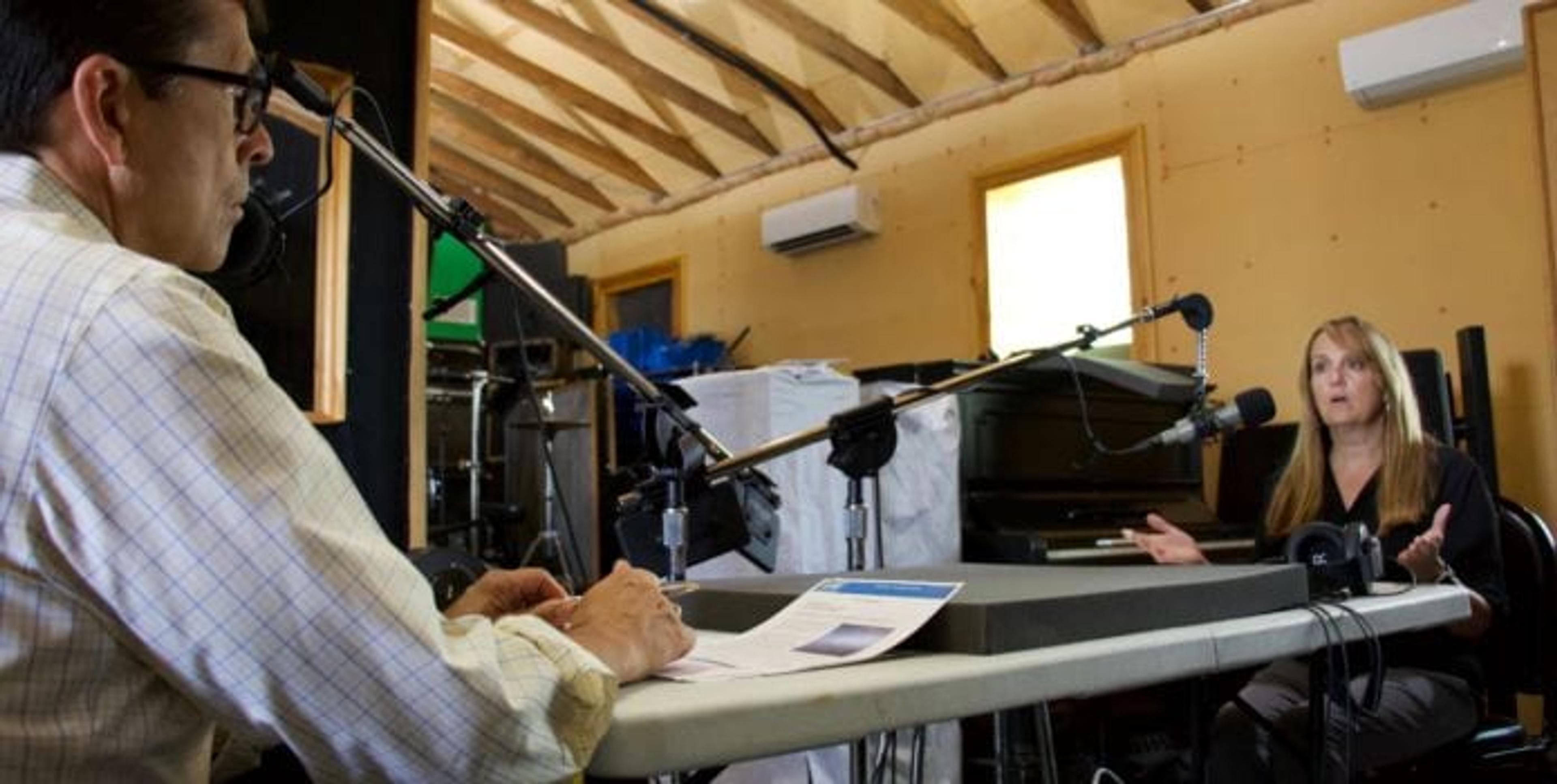Wellness Tips for the Workplace
| 1 min read

00:00
00:00
About the Show
On this episode, Chuck Gaidica and Cindy Bjorkquist discuss why well-being in the workplace is good for business.
“If you have a high sense of well-being at the work site … you’re going to have a resilient employee,” Cindy Bjorkquist
In this episode of A Healthier Michigan Podcast, we explore:
- The definition of well-being vs. wellness.
- Why employers should embrace well-being in the workplace.
- Bringing kindness and compassion into the workplace.
- The need to unplug and refresh your brain.
- The idea that putting yourself into a stressful situation will help you be more resilient.
- Physical health and well-being are equally important.
Transcript
Chuck: This is A Healthier Michigan Podcast, Episode 11. Coming up, we’re talking about wellness tips for the workplace.
Chuck: Welcome to A Healthier Michigan Podcast, the podcast dedicated to navigating how we can all improve our health and well-being through small healthy habits that we could all start today. I mean that’s the cool part, we can walk away with a goal list of what we should be doing. I’m your host Chuck Gaidica. Each week we’re going to sit down with a certified health expert from Blue Cross Blue Shield of Michigan to do a dive into topics covering nutrition, well-being, wellness, stress reduction. In this episode we’re talking about well-being in the workplace. How do we get to that point. Joining us again, we’ve got Cindy Bjorkquist, who’s with us. She started out years ago. Not that many. I think … What? Two, three years ago? No. 33 years ago. Exercise physiologist who has migrated now to become the Director of Health and Wellness Programs at Blue Cross Blue Shield of Michigan, of course the largest health insurer in the state of Michigan with over 4.5 million members. So we know somebody is listening to Cindy’s wisdom. Good the see you again.
Cindy: Aw, you’re so kind.
Chuck: No, you …
Cindy: And compassionate. You’re so nice.
Chuck: You are so helpful in guiding us through this and being up to this episode. What are we? Episode 11, right?
Cindy: I know.
Chuck: Talking about well-being, we’ve been doing that. Let’s set the table at the beginning. Wellness is a phrase that we’ve heard for a long time as a word. Moving to well-being, what’s the difference again?
Cindy: Right. So wellness is your physical health, and we’ve been doing that for 40-some years employer sites in the industry, work site wellness. So your cholesterol, your blood pressure, your height and weight for your BMI. You know, those sorts of things. Now it’s expanded to well-being, and so well-being is that physical, plus emotional health, plus financial health. Where’s your mind going? Can you change your default setting? All the podcasts that we did before this one. The reason why employers are interested … So our previous podcast talked about why a person should be interested in well-being. The employer’s interested in these well-being programs, because it really impacts, as a natural, their productivity of their workers and their healthcare cost.
Cindy: And so according to Gallup, the number one contributor to rising healthcare costs and low productivity, is low employee well-being. So before we cited it as employee wellness, and we worked for years trying to get people healthy. But now it’s extending more than that.
Chuck: Yeah.
Cindy: So what these employers are doing, is they’re understanding that if they can get their employees to a high sense of well-being, then they have a 19% higher work output. They’re more productive. They rate their team’s work output as 20% higher. That’s kind of a natural. You have a social connection with the people, you’re mindful, you’re focused, you’re …
Chuck: You’re happier, maybe? More joy in your life?
Cindy: Yeah. Yeah. You’re working with these people better, so you have a 20% higher output, and that also … They’re more likely to stay with the employer. And so those millennials, we talk about that a lot with employers. They’re looking for work sites and employers that have this sense of well-being. They’re looking for something different, and they know that in their head. So actually, the Society of Human Resource Management found that companies with a robust well-being program are 2.5 times more likely to be viewed as a top performing organization. And so you hear this on national news all the time. CEOs are being mindful and doing meditation-
Chuck: Yeah.
Cindy: … and they’re helping enhance their own programs, and they’re kind of incenting their own employees to go into this space. So it is something huge.
Chuck: But see, we’ve learned from and from all the great stats that you’re able to distill for us and give us an idea of what it really means to all of us, this is way more than just meditation. Whether it’s at work or at home. This is trying to bring balance to your life. And as you put it, if you’ve got a financial stressor in your life, or you’ve got a personal fight at home, whatever it is, that can be taken to work.
Cindy: Right, exactly. Exactly. So one of the best quotes I like to reference when we’re talking about this for employers is there’s this sense sometimes at an employer’s site that if I do unplug, and I do take a mindful moment, and I do relax, that I’m not the person who’s going to be the highest productivity. But it is in reverse, so this famous quote by Anne Lamott is “Almost everything will work again if you unplug it for a few minutes, including yourself.” And that’s really important, because we have to allow our brain to cleanse itself and to come down and to refocus, and that’s what all of this meditation and mindfulness is doing.
Cindy: Beyond the meditation and mindfulness, at the employer site, some of the things that they’re doing … And we talked a little bit in an earlier podcast about this, but this kindness and compassion. So also bringing that into the workplace is super important. We spend about a third of our life working at the workplace. That’s a lot of time. So there’s a stat out there. 50% of US adults who leave their jobs do so to get away from their leadership. So imagine if you could take this mindfulness, this meditation-
Chuck: Yeah.
Cindy: … and workplace well-being, and fuse that into your leaders. Then you’re going to have more productive, more creative workers, they’re going to probably stick around, you’re going to have a higher retention, you’re going to have more people want to work at that. So that’s kind of where they’re going with why they’re offering all these different classes. And so there’s also this sense of bringing this to leadership. So leaders are subjected to constant pressure all the time. If you’re in a leadership role, you have to make tough decision every day, and you’ve got to do strategies and you have your P&L, and you’ve got to defend what you’re doing, and you’re responsible for all of these different strategic outcomes. So what they’re finding is that if you bring this kindness and compassion under this big umbrella-
Chuck: Yeah.
Cindy: … of well-being, if you bring that into the workplace and do a program on it, that leaders, they’re finding, are less empathetic because their brains are rewired to kind of … It sounds crass, but stop caring about people and getting the objective and the target and the goal done.
Chuck: Get it done. Just get it done.
Cindy: Yeah. Yeah. So that’s why a lot of these CEOs of Fortune 500 companies, and even companies that we employ programs with Blue Cross, they’re starting to do these kindness and compassion classes for their employees. And it’s a fascinating field.
Chuck: Well, you know there’s also a perception, I think … I’ll just speak for myself. I think there’s a perception that I’ve had, and it’s my own baggage, that if I’m being a servant leader, and I’ve done that in and out of the ministry world and other places, there’s this … In my mind I’m thinking that makes you look weak.
Cindy: Yeah, yeah.
Chuck: Right? That you’re serving others, you’re serving your team so the team can move on to the goal line. And I think it’s quite the opposite. When those people see that you’re standing shoulder to shoulder with them in the deep muck … I mean, you know? You’re able to perform. And then all of a sudden everybody is helping everybody else.
Cindy: Exactly.
Chuck: It’s counterintuitive.
Cindy: Exactly. And there’s three quick kind of hints that you could give a leader right away, from some of this research.
Chuck: Okay.
Cindy: One is that leaders need to be proactive in what they do with their staff. Exactly what you’re talking about. They need to apply compassion to any engagement. So how can I benefit that person? How can I help that person? You’re compassionate about that person. If that person feels their leader is compassionate towards them, that’s one more step to their well-being. And an example of this is I read an article about the CEO of Cisco, and he actually writes a personal letter to extend support to his employees who suffered a family loss or a severe illness. Think about that. Not just their leader, but the CEO of the company-
Chuck: Yeah.
Cindy: … is being compassionate and empathetic towards their people that work for them. That’s huge for that company. So and along with that, another tip that a lot of these companies are doing, is this daily compassion meditation. I think we talked about this in one of the podcasts.
Chuck: Yeah.
Cindy: But in the meditation classes, they’re actually having a person visualize somebody who’s going through a struggle, maybe going through a divorce or going through a loss of a family member or whatever. And helping that person, thinking empathetically towards that person, extending the kindness and the compassion. It could be a phone call, it could be an email. Sometimes it’s just meditating and thinking about that person, but it does wire you differently. It wires your outlook differently, which translates to you being different in the workplace.
Chuck: There’s something else that we’ve talked about multiple times in the past couple of podcasts, and that’s this idea of being in the moment.
Cindy: Yeah.
Chuck: We hear the word mindfulness, or the word, and the intent is that when I’m sitting with a fellow employee, or if I am a leader, and all I’m doing is looking at the phone while you’re trying to share with me details of the project I’ve given you, or the problem you’re having to get the ball moved down the path, I’m not in the moment. I mean, I’m not paying … We always get hard on the employees, that, well, they’re on the computer looking at something else. Sometimes you’re trying to find the person who will help you, coworker or a boss. And if all I’m doing is checking something to make sure that everything’s working well? Just be in the moment with each other, just-
Cindy: Absolutely.
Chuck: Because you’re connected, then.
Cindy: Right. And think about how you would feel as an employee-
Chuck: Yeah.
Cindy: … if you knew your leader was focused on you, was compassionate towards you, empathetic towards you, wanting to help you get your goals too, but they fused that all in. That is vastly different than what our industry has been doing for the past 30-some years, which is just physical health and wellness. I mean we always had a touch of stress management in there, but stress management was different. Stress management was old-school think of the things that stress you out, write them down, and then try to enable yourself to correct those.
Chuck: Yeah.
Cindy: And there’s some fascinating research about neuroscience where if you write the things down that stress you out, you actually fire mirror neurons in your brain that could stress you out a little bit.
Chuck: Because you’re seeing them in writing?
Cindy: Yeah, right. Exactly.
Chuck: Oh my god.
Cindy: Yeah, you’re writing them down. So the industry has moved from that old stress management technique to building resilience. I mean I’m at the point where I can build myself to be very resilient, and that’s what workplace well-being classes are focusing on, is this whole idea of all the different components that I can do to make my employees as resilient as they can, as mindful as they can and focused and creative. All of these things are bundled together.
Chuck: Well then let me as you the … It’s a question that is lurking in my mind since we started this episode. Why don’t organizations and companies understand this idea more? Because if you were to treat your employees the way you just described, all the positives, they would walk on hot coals for you. Well then why aren’t we seeing more of this happening? Or are we, and we just don’t hear it?
Cindy: I think we are hearing more … So the industry is pushing employers to that point.
Chuck: Okay.
Cindy: So in the past 33 years I’ve been doing this, we’ve always kind of touched on this stuff. It’s just that we’re focusing on it more now. And the science is behind it. Remember the earlier stat?
Chuck: Right.
Cindy: And 1981 study, now there’s multiple studies every month on it.
Chuck: Dozens, yeah.
Cindy: So it’s science-based. It went from “We think it does this.” To science-based. MRI scans and research done on it.
Chuck: Right.
Cindy: Which is really substantiating why employers should be focusing on these different programs. So going back … I just want to touch on this, because it’s important. Because this all blends together, that if you have a high sense of well-being at the work site, that you’re going to have a resilient employee. That’s a buzzword people are going to hear in the industry. So what does it take to be resilient? If I was an employer, and I was trying to make my employees as resilient as they can, to all the things that hit them from the minute they get up to the minute they go to bed.
Chuck: Right.
Cindy: What do they have to do? So Dr. Charney and Dr. Southwick were authors of this article that I read, it’s called Resilience: The Science of Mastering Life’s Greatest Challenges. And there’s six quick points there, and they’re really interesting. One, practice optimism. We’ve talked about that a lot. It’s part genetic, right? Some people wake up happy, some people are positive. If you’re not, rewire your brain. Rewrite your story. Reframe your personal narrative that shapes your view of the world. So if you’re on a certain path, and you want to change that path, then you journal about it. You write about it. And you can get yourself to that point to rewire your brain. Don’t personalize things that blaming yourself. If you have a setback, don’t blame yourself. Just look towards the positive future. Remember your comebacks. If you did a good job and came back from something because you were resilient-
Chuck: Yeah.
Cindy: … celebrate that, journal about it, talk about that. Support others, community, other people in your social support. We talked about that earlier in a different podcast. Really important to surround yourself with people who are positive, who are happy, and that social contagion. And then also remember, stress breaks are good. You have to allow your body to recover from stress, so take your vacation. How many people do you talk to-
Chuck: Yeah.
Cindy: … that almost wear it like a badge that they have not taken a vacation?
Chuck: Oh, I know.
Cindy: You have to unplug yourself and refresh your brain, and get out there and have adventures, and then come back to your job and be more productive. There are actually companies that I have talked to that mandate vacation time. Your employees have to take … I love that. They have to take their vacation time. And I actually talked to one employer who demanded that that person not do one single email while they were gone on vacation. You will not … I had a boss this one time, I loved it. You will not answer one email on your vacation. Do not …
Chuck: That’s great.
Cindy: Do not log in on your iPhone, all that kind of stuff. The sixth way to build resilience, the last point, is to get out of your comfort zone and put yourself in different challenging situation. Because interesting enough, the stress hormone system that will respond when you’re in an adventure, or you say you climb a mountain where you do something like that.
Chuck: You mean like cortisol? Whatever is racing. Adrenaline? That stuff.
Cindy: Yeah, yeah, yeah. You get better able to handle stress, and so you’re more resilient. So there’s this idea out there that … Put yourself in a stressful or resilient or uncomfortable position-
Chuck: Yeah.
Cindy: … and it’ll actually help you be more resilient. Because you’re not letting your emotions take over, you’re actually better able to bounce back from that.
Chuck: See, that’s brilliant. Because it’s not just getting resilient for your own sake. Because we know in the business world and the workplace, there’s going to be stuff that’s thrown at you every day, where it zigs instead of zags. And if you’re able to handle that and not have it melt down your entire afternoon? What a better employee you’re going to be.
Cindy: Absolutely.
Chuck: What a better boss you’re going to be.
Cindy: And even before you get to work. Think of trying to get … I remember trying to get my two boys read and off to school. Or your commute to work, or trying to find a parking space. All that could set you up as a negative state of mind before you even open your first email at work, you know?
Chuck: Right.
Cindy: And you don’t want to bring all of that home, so you want to do this separation of “Now I’m home, so now I want to be focused and mindful and resilient for all the things that I’m doing with my family and my kids when I’m at home as well.”
Chuck: You reminded me by bringing up the idea of travel, taking your vacation, your sabbath time. Take some downtime, right?
Cindy: Yeah.
Chuck: My daughter went to work for a travel company. I said to her when she accepted the job “So how much time off do you get?” She said “I asked that question, the answer was ‘You take as much as you like. We know you’ll be fair.'”
Cindy: I heard about that.
Chuck: Now here’s what’s really cool. I said to her “How does that work out on average?” She’s asked, now that she’s secure in her job and she could ask her boss. On average, most employees are taking what they know would be average for their length of time of service, and they don’t abuse the system. And if one year they needed an extra three days, the boss is like “I told you, it’ll all work out.” And because it’s the honor system, it actually does.
Cindy: Think of the retention of those employers.
Chuck: Yeah. Well, I’m telling you about it.
Cindy: Yeah.
Chuck: I mean, I’m kind of bragging about … I wish I had bosses that would have told me that, you know?
Cindy: Yeah.
Chuck: Yeah.
Cindy: That’s amazing. That’s amazing.
Chuck: So if we bring it all together, I think what we’re learning in these podcasts all together is this idea of having balance, right? This notion of resilience is a matter of getting resilient because we’re allowing all these things in our life to … Not toughen up, but just be able to adapt better.
Cindy: Right, right.
Chuck: Yeah.
Cindy: And remember, with resilience and mindfulness and all the things that we’re talking about, don’t forget about that physical well-being as well. We’re not abandoning that physical health. I mean you need to know where you are situated with your health. Are you on track to having heart disease or high blood pressure? Or your BMI is getting out of control, so you’re going to get type two diabetes.
Chuck: Right.
Cindy: We’re not saying that that is any less important, because physical health and well-being is very important. But it’s all this added research-based stuff that they’re adding, which umbrellas you into well-being.
Chuck: What I find fascinating is the day of the cool company putting in the ping pong table and the pool table, not to take anything away from that. That this stuff all sounds so … It just sounds so like it’s in the cloud, you know? Like “Oh, we’re going to deal with well-being.” And yet, when I hear all of this from you and all the research, it’s far more important-
Cindy: So you know what those people are doing now, along with the ping pong table? They have a meditation room.
Chuck: Do they really?
Cindy: Yeah. So we have employers who are a small room. Its dark, there’s some pillows in there. There might be some fake lit candles.
Chuck: Wow.
Cindy: And you’re meditating, and you’re breathing because those employers understand when you go back to your job, you’re more focused, more creative and more productive.
Chuck: Cindy Bjorkquist has been with us. Good to see you again.
Cindy: Good to see you.
Chuck: We get one more together, don’t we?
Cindy: One more.
Chuck: I’m looking forward to it. Thanks for listening, this is A Healthier Michigan Podcast, brought to you by Blue Cross Blue Shield of Michigan. If you want more information you can check us out online, ahealthiermichigan.org/podcast. You can leave a review there, you can leave a rating on iTunes or Stitcher, and you could also get new episodes on your smartphone or your tablet. You can download them through Apple Podcast, Stitcher or your favorite podcast app. Next week, join us, because we’ll be talking about how we find balance. We’re going to bring together all these … What? Half dozen or more podcasts in this particular season we’ve been talking about well-being, wellness. Bring it all together. Everything we’ve learned through the well-being series, putting it into practice so that you’re not overwhelmed. You could have a go-to list of things you can start today, to actually start to see change in your life. And you’ll feel better. How do we find this balance, moving forward? That’s next time, right here.





